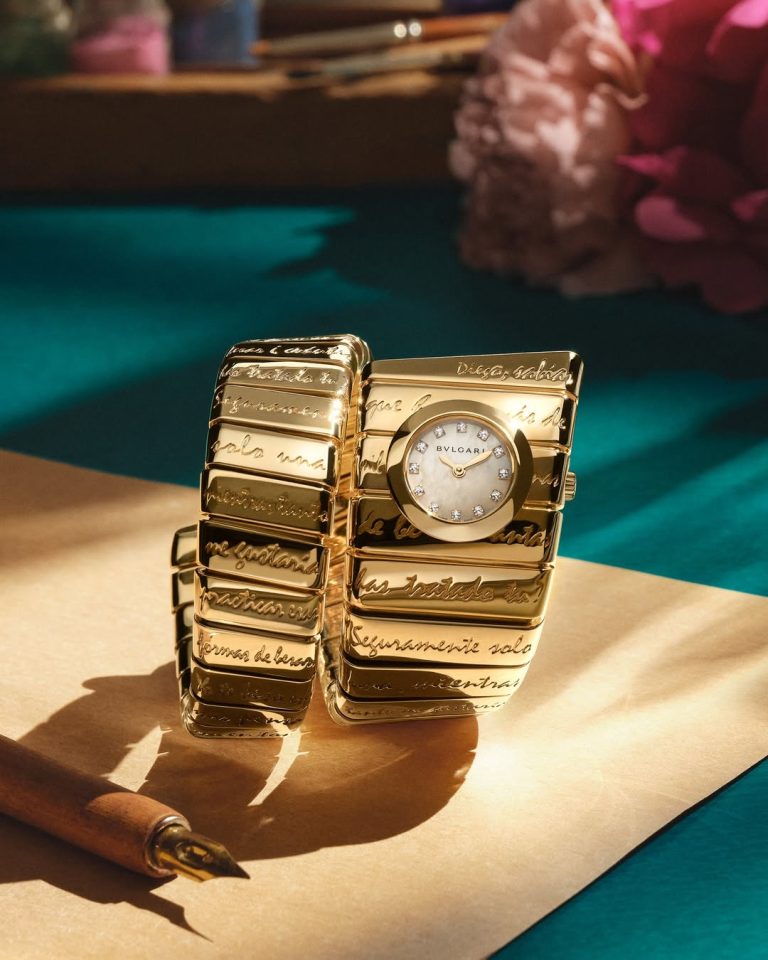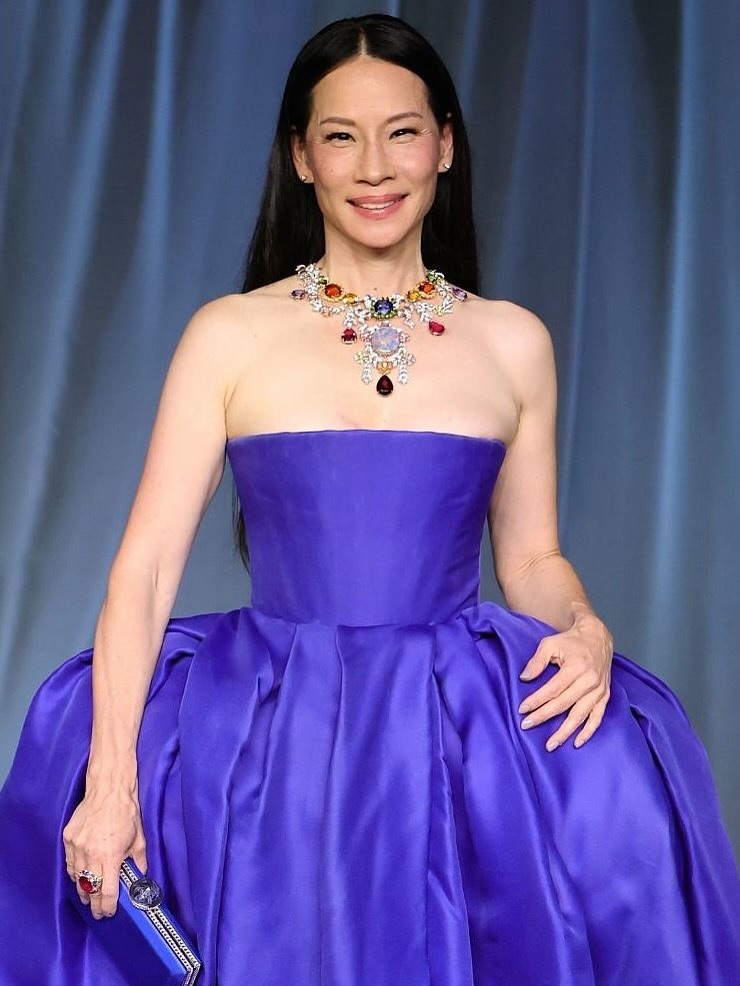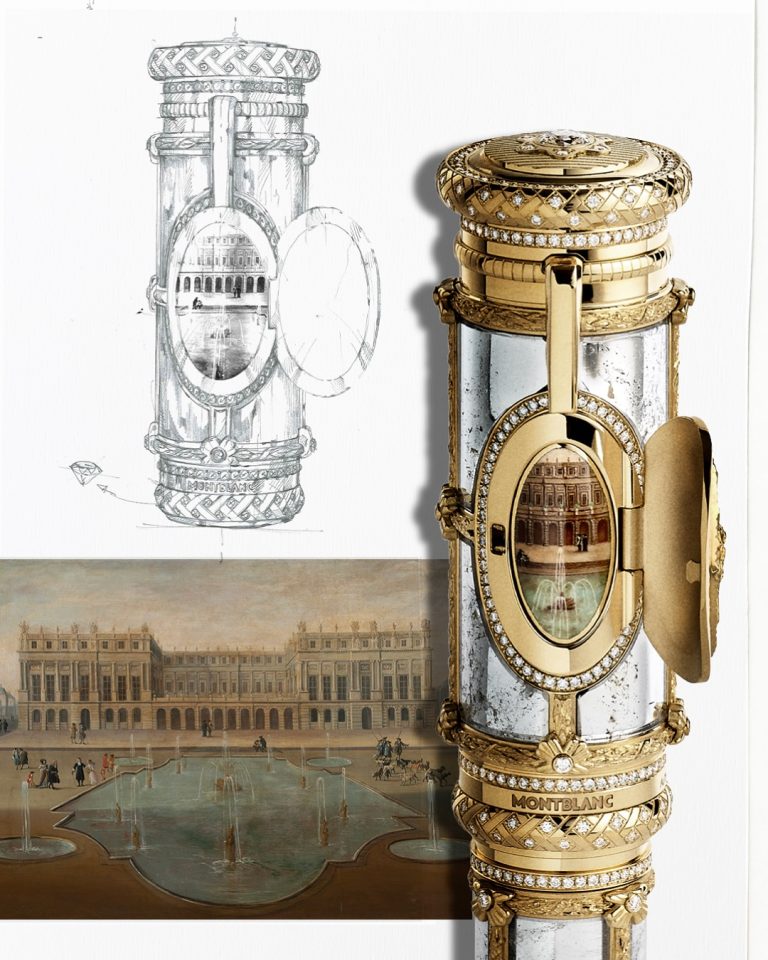I had the most vivid dream last night—a journey back in time to a world immersed in opulence, a world where legendary crowns and tiaras reign supreme. I found myself in a room bathed in candlelight, the air heavy with anticipation. Before me unfolded the coronation of an ancient monarch, a scene so alive I could feel its pulse. At the center of the room stood the monarch, poised yet reverent, and a crown—an exquisite creation of diamonds, sapphires, and centuries-old gold—was gently placed on their brow. The whispers of history seemed to echo through the room. I could feel the immense weight of power and legacy reflected in the glint of every gemstone.
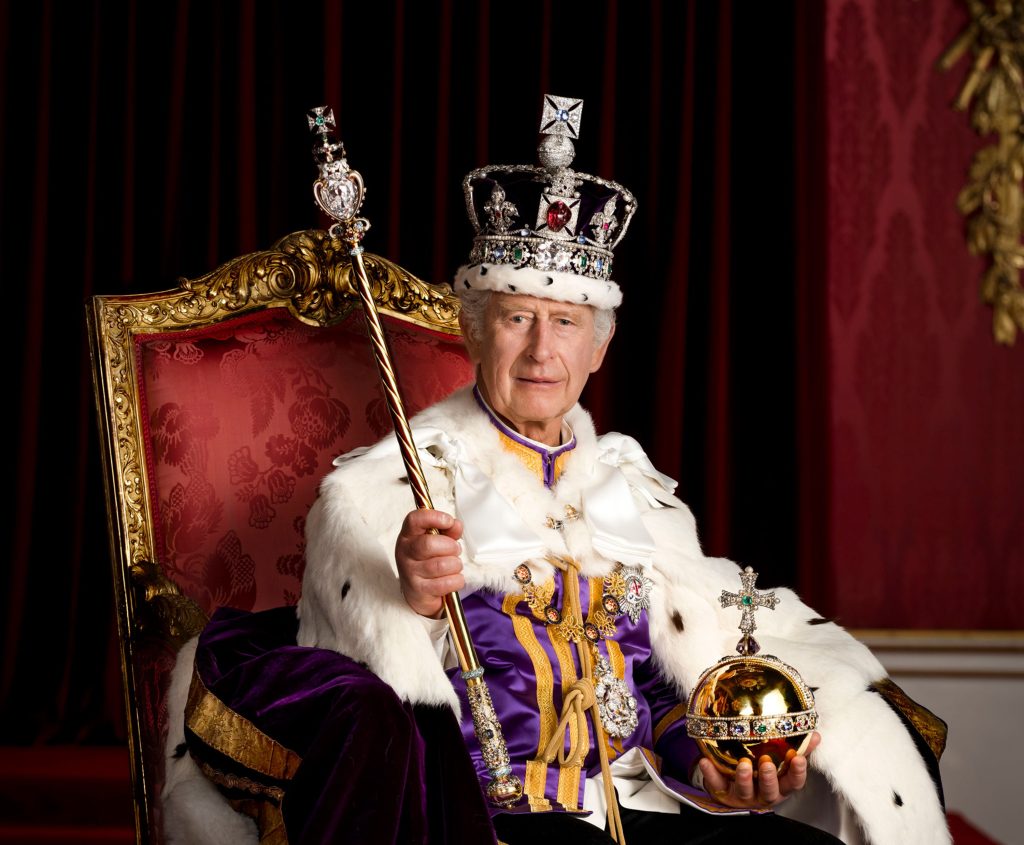
In the next instant, a queen entered the scene, draped in regal finery, her towering hairstyle accentuating her stature. A tiara was bestowed upon her—a dazzling masterpiece that caught the light with every movement. The room seemed to hold its breath. What a moment to witness!
I woke up captivated. I wanted to know more. What stories do these legendary crowns and tiaras hold? Each one seems to tell its own tale: empires risen and fallen, love stories immortalized in jewels, and sacrifices etched into the very metal.
The Stories Behind the World’s Most Legendary Crowns and Tiaras
Throughout history, royal crowns and tiaras have stood as dazzling symbols of power, prestige, and the enduring mystique of monarchy. These legendary artifacts crafted with the rarest jewels and steeped in stories of triumph, tragedy, and tradition, are the silent witnesses to centuries of coronations, revolutions, and whispered intrigues in gilded halls. From the iconic Imperial State Crown of Britain to the shimmering Braganza Tiara, each tells a tale of its own—of rulers who wore them, the nations they represented, and the legacy they carry.
Come with me; let me take you on this journey through time. Together, let’s uncover the stories behind the world’s most legendary crowns and tiaras. Because while monarchs may pass, the allure of their treasures is eternal.
The British Imperial State Crown (United Kingdom)
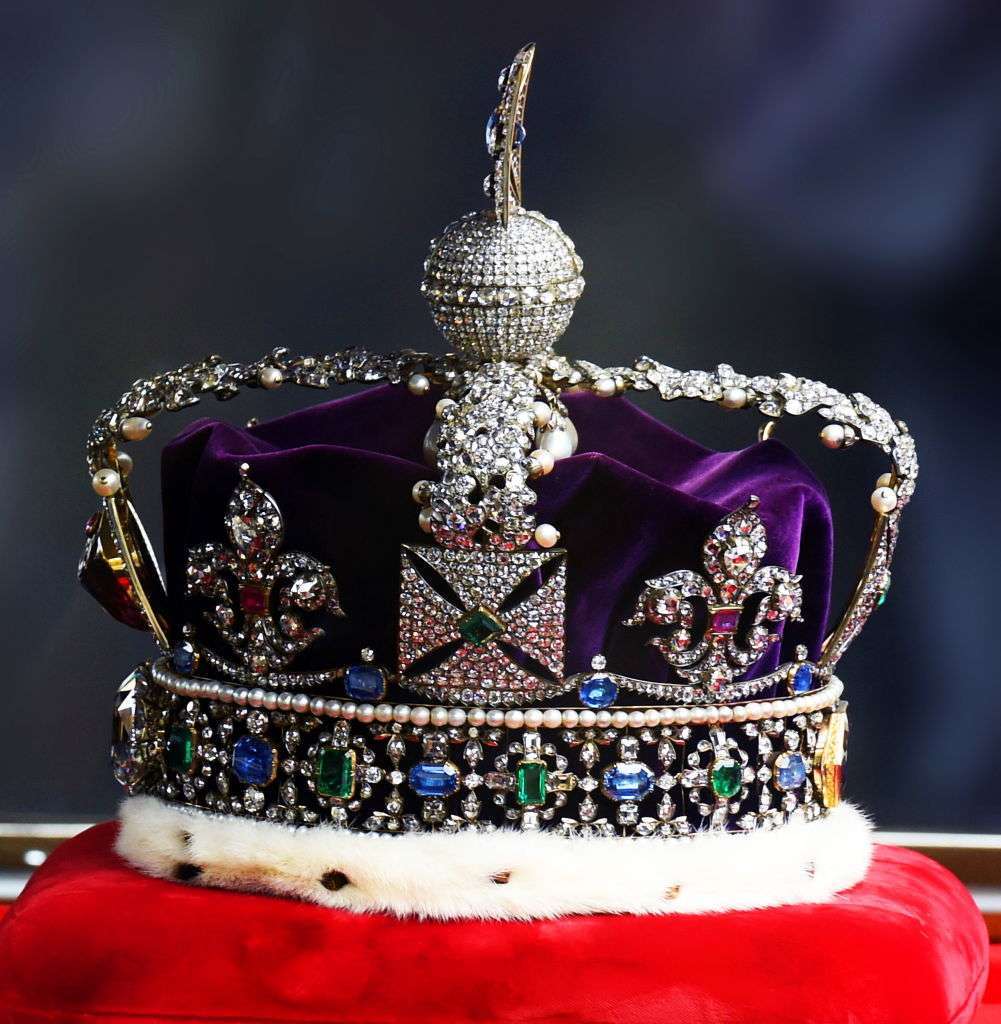
Our journey begins with none other than the most legendary crown in the world—the British Imperial State Crown. This magnificent symbol of the British monarchy’s enduring power is a testament to history itself. Created for King George VI’s coronation in 1937, it is rich with meaning and marvel, weighing in at a majestic 1.06 kilograms. But its history stretches far beyond that. The crown contains 3,170 precious gems, including the 317-carat Cullinan II diamond—affectionately known as the “Second Star of Africa.” This massive stone commands attention at the front of the crown, while the Black Prince’s Ruby, a deep red spinel of 170 carats, and the Stuart Sapphire, with its haunting blue hue, add depth to its magnificence. And above them all, the sacred St. Edward’s Sapphire, said to have belonged to Edward the Confessor, glistens with centuries of royal reverence. Worn by monarchs at the State Opening of Parliament and after coronations, it held a poignant place atop Queen Elizabeth II’s coffin at her funeral, linking the past to the present, the living to the dead.
The George IV Diamond Diadem (United Kingdom)
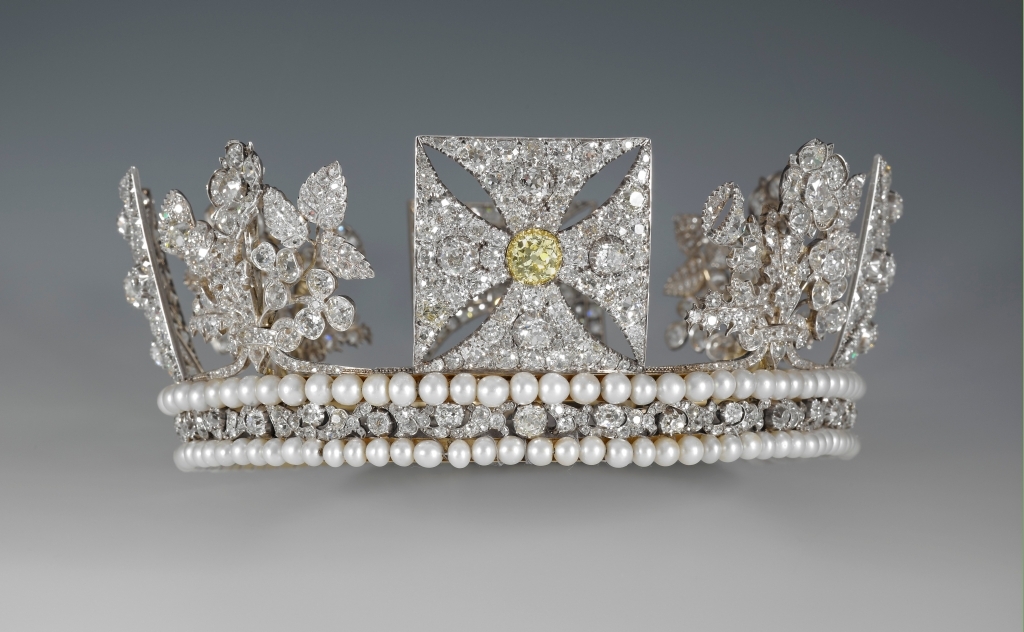
Next, we turn to the George IV Diamond Diadem, commissioned in 1820 to Rundell & Bridge for King George IV’s coronation. The diadem set with 1,333 diamonds is an exquisite reflection of the royal family’s refined taste. The central yellow diamond shines like the sun, surrounded by delicate floral patterns that symbolize the unity of the United Kingdom—roses for England, thistles for Scotland, and shamrocks for Ireland. Yet, despite its origins as a symbol of a king’s power, this diadem is more closely associated with British queens. Queen Elizabeth II wore it during her coronation procession, its image even gracing British banknotes and stamps. The diadem remains an icon of royal continuity, cherished through the centuries as a deep symbolism and history.
The Imperial Crown of Russia (Russia)
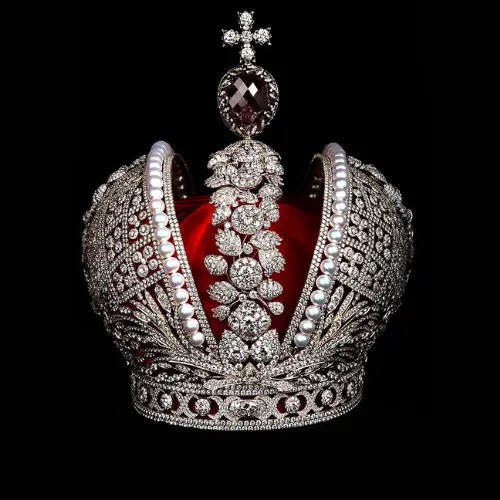
We journey now to Russia, where the Imperial Crown stands as a reminder of an empire’s opulence and its tragic fall. The crown, crafted in 1762 for the coronation of Catherine the Great, is a masterpiece of craftsmanship and opulence. It is set with 4,936 diamonds and crowned by a 105-carat red spinel—the largest of its kind in the world. It is a crown that has witnessed the rise and fall of tsars, including the tragic reign of Tsar Nicholas II, Russia’s last emperor. After the Russian Revolution of 1917, the crown was locked away in the Kremlin Armoury, where it remains to this day—a poignant symbol of a lost Russian empire and the passage of time.
The Large Diamond Tiara (Russia)
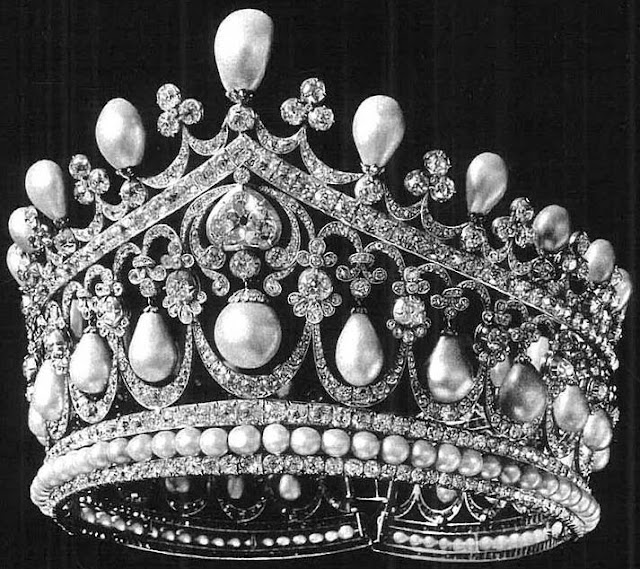
Equally remarkable is the Large Diamond Tiara, crafted in the early 1830s for Empress Alexandra Feodorovna, the wife of Tsar Nicholas I. Adorned with 500 diamonds and 113 pearls, this tiara is a shining example of Russian luxury. But like many of the Romanov jewels, it met a tragic fate after the Bolshevik Revolution. Most of the Romanov family’s treasures were lost, sold, or hidden to fund the new Soviet regime. The tiara’s fate remains shrouded in mystery, but historians believe it likely ended up in private hands or was dismantled for its diamonds. Its story is a reminder of the shifting tides of fortune that have claimed the jewels of dynasties long past.
The Pahlavi Crown (Iran)
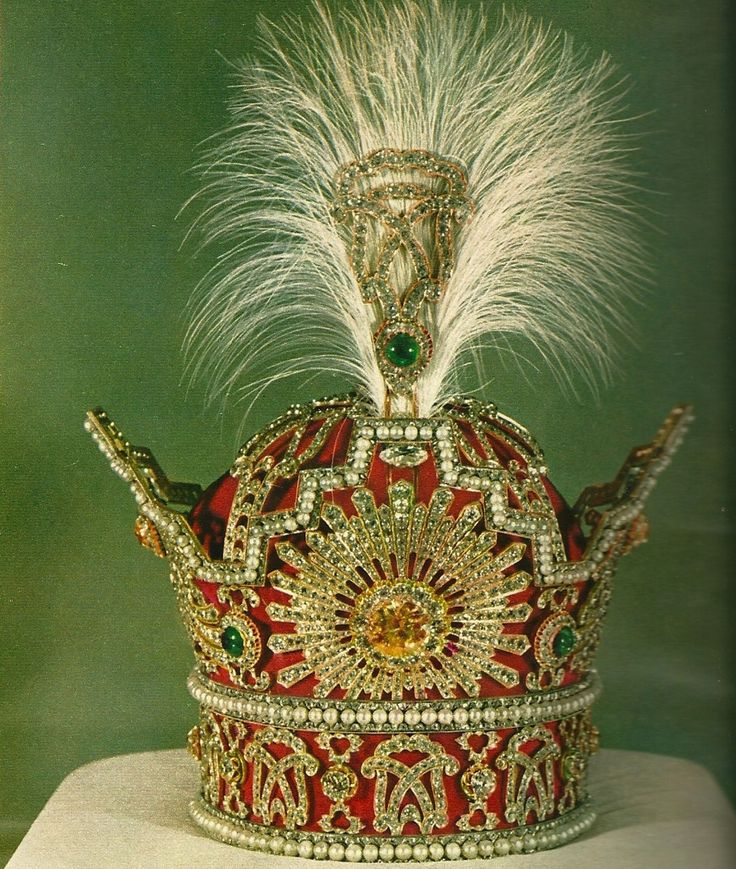
In Iran, the Pahlavi Crown is another symbol of monarchy’s grand transformation. The crown was commissioned in 1926 for the coronation of Reza Shah and was designed to reflect the modernity of Iran’s monarchy. Adorned with 3,380 diamonds, including a stunning 60-carat yellow diamond at the front, and further embellished with emeralds and pearls, the crown is a masterpiece of opulence. Both Reza Shah and his son Mohammad Reza Pahlavi wore this crown during their coronations. Today, it resides in Tehran’s National Jewels collection, a relic of an era that came to a sudden end with the 1979 Iranian Revolution, leaving behind a shadow of what once was.
The Empress Crown (Iran)
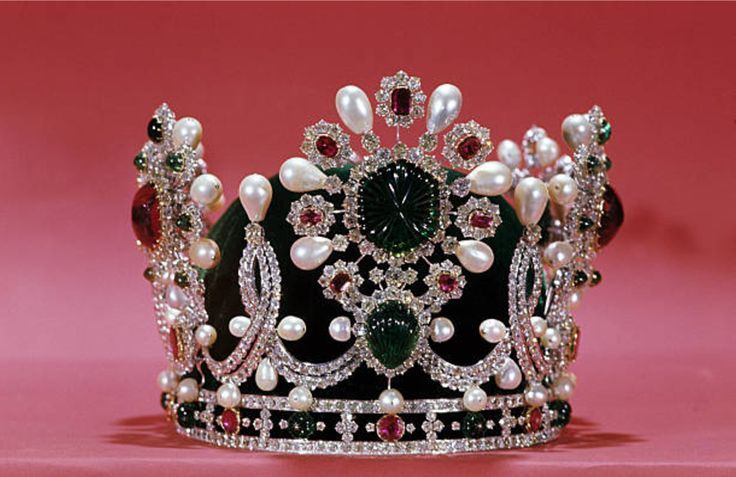
Let’s pause to admire the empress crown (also known as Shahbanu’s Crown)—a crown for a 1960s queen but with a very modern twist! The breathtaking crown was crafted by the famous jeweler Van Cleef & Arpels for Farah Pahlavi, the first empress of modern Iran, in 1967. It features 1,469 diamonds, 36 emeralds, 105 pearls, and 36 spinels and rubies—stones from Iran’s treasury. The centerpiece is a 91-carat emerald, a stone of remarkable beauty and significance. However, following the revolution, the crown, like the Pahlavi family, was exiled. Left behind, it now resides in the Central Bank of Iran, a relic of a bygone era that symbolizes the end of monarchy in Iran and the beginning of a new chapter.
Turban Ornament (Jigha) of the Maharaja of Nawanagar (India)
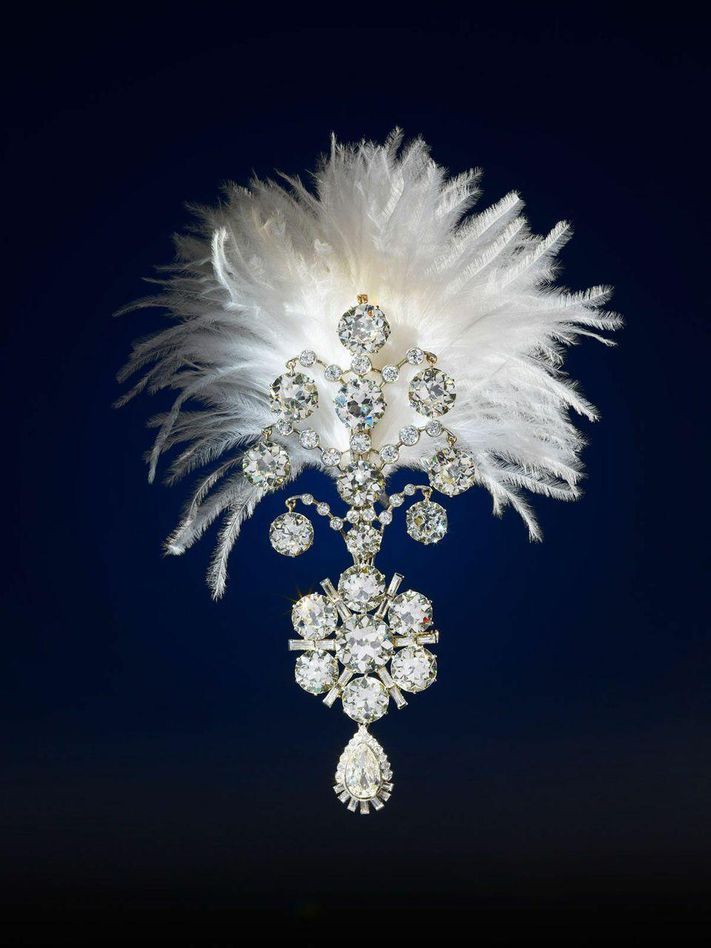
Still on a royal tour of the world’s most legendary crowns and tiaras, we find ourselves in India to take a look at the jigha, also known as turban ornament. This ornament was a prominent symbol of royalty, status, and privilege in India, especially among the princely states during the late Mughal era and the British Raj. The emperors and high-ranking nobles of the time wore elaborate headpieces to symbolize their authority and to set them apart within the social hierarchy. Maharaja Ranjitsinhji of Nawanagar commissioned Cartier in 1907 to make his jigha, an ornament adorned with 152.60 carats of diamonds and soon became a mark of distinction. The fate of this Jigha remains uncertain, likely dismantled or lost during the political upheavals that reshaped India’s history.
The Great Crown of Victory (Thailand)
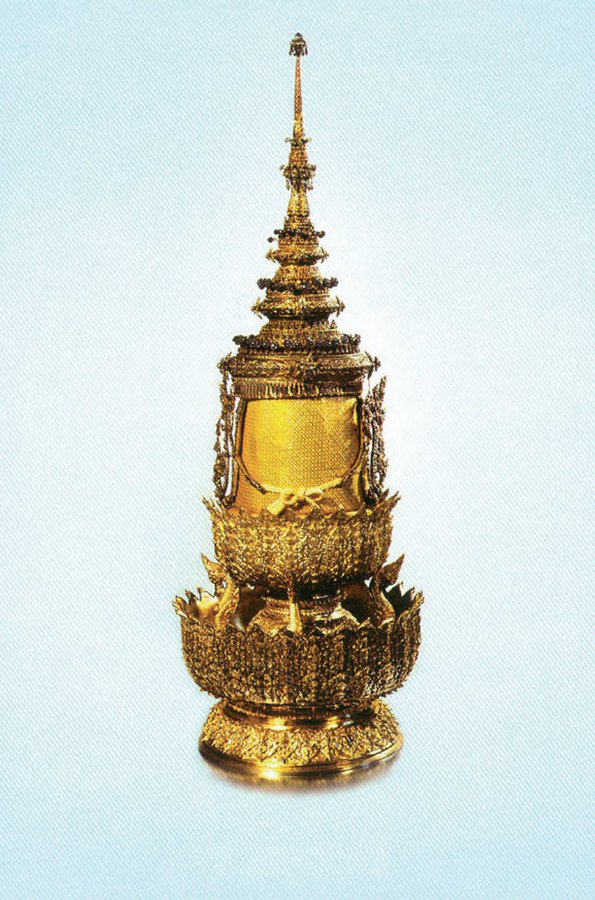
Come with me to Thailand to take a look at one of the heaviest royal crowns in existence! The Great Crown of Victory, or Phra Maha Phichai Mongkut, is one of the most important and sacred symbols of Thai royalty and was crafted in 1782 during the reign of King Rama I. Made of solid gold, the crown is 66 centimeters (26 inches) high and weighs 7.3 kilograms (16 pounds). The intriguing thing about this crown is that it is only worn by the king during his coronation ceremony, and he must place it on his own head. No one else is allowed to place the crown on the king’s head. The crown has been used in the coronations of all Thai monarchs from King Rama I to the current King Maha Vajiralongkorn (Rama X), who ascended the throne in 2019.
The Braganza Tiara (Sweden)
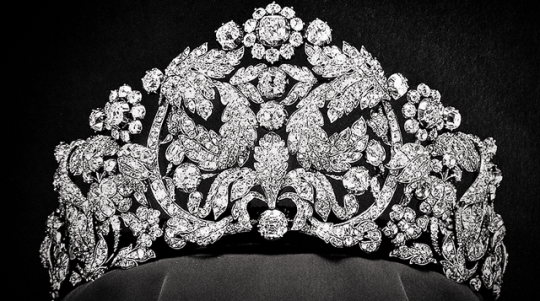
As one of the most magnificent pieces in the Swedish royal collection, the Braganza Tiara has a fascinating back story. It was originally made in 1829 for Empress Amélie of Brazil, the second wife of Emperor Pedro I. When the emperor decided to remarry after the death of his first wife, Maria Leopoldina, he bought diamonds belonging to his late wife from their children to craft this stunning tiara. This tiara, said to have been made in France, features a spectacular design of towering diamond scrolls and was part of a full parure, which included a diamond rivière, large diamond earrings, and a diamond floral brooch. The Tiara has been worn by Swedish queens on important occasions, most notably by Queen Silvia, the current Queen of Sweden, who frequently wears it for important state banquets and royal celebrations.
King Erik XIV’s Crown (Sweden)
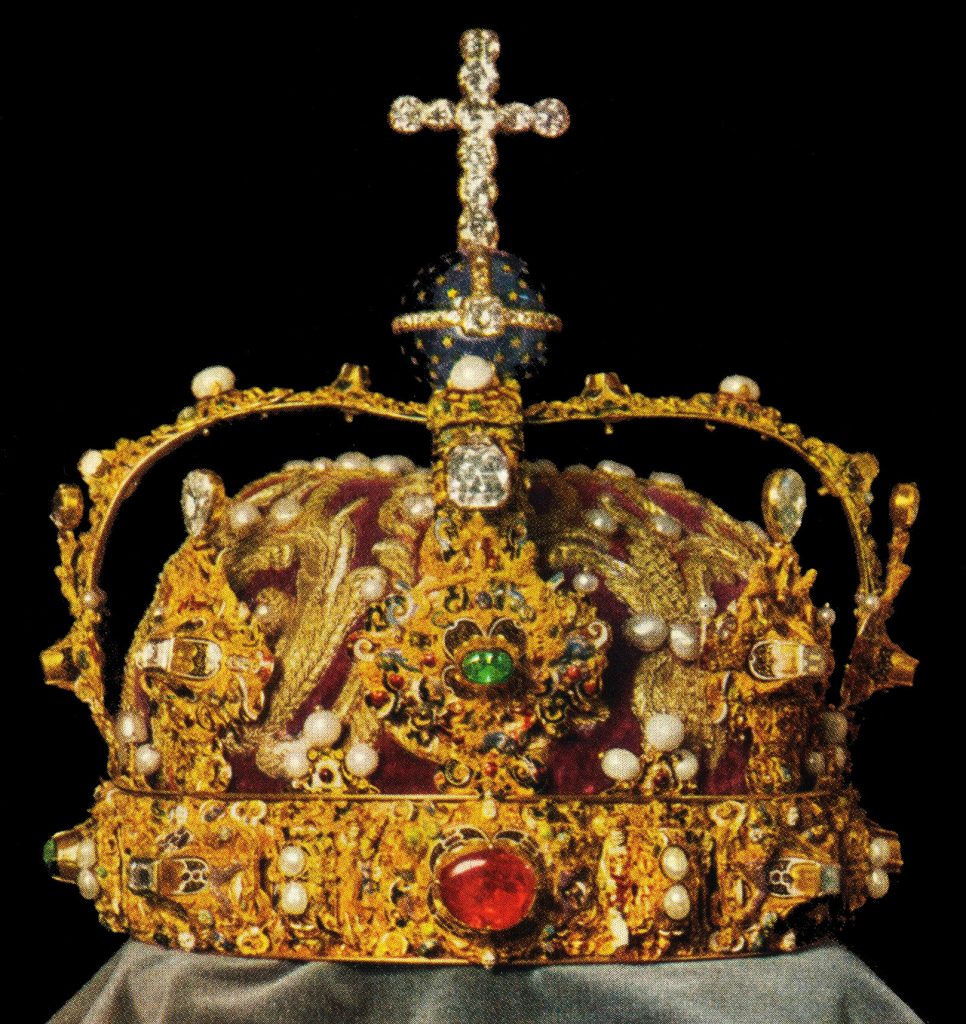
We are still in Sweden to catch a glimpse of the Crown of King Erik XIV, the oldest royal crown still in use today! Designed for Erik XIV’s coronation in 1561, is decorated with a mix of gemstones, including diamonds, rubies, emeralds, and pearls, all set in an intricate gold framework. There are small figures of women around the crown symbolizing the cardinal virtues: Justice, courage, prudence, temperance, faith, hope, compassion, and patience. The crown was initially made for a Renaissance king, but its design has a timeless elegance that has kept it in use for over 450 years. It is now part of the Swedish royal regalia and it’s being kept at the Stockholm Palace Treasury. It is still used in coronation ceremonies as the official crown of the King of Sweden, despite its ancient origins.
The Benkan Crown (Japan)
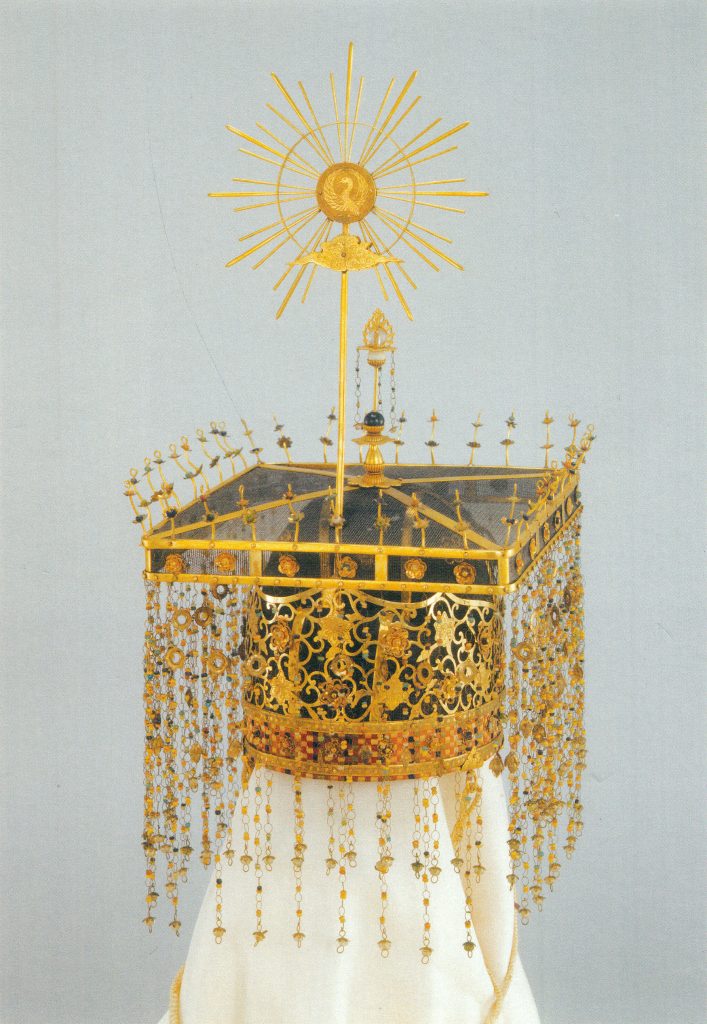
Now, we arrive in Japan, where the Benkan Crown is the epitome of imperial Asian tradition. Symbolizing the divine connection of the emperor to the sun goddess Amaterasu, it remains one of Japan’s most sacred regalia. Though last worn in 1847, the Benkan Crown remains a powerful symbol of Japan’s imperial past, woven into the fabric of its identity.
The Asante Ceremonial Cap (Denkyemkye) (Ghana)
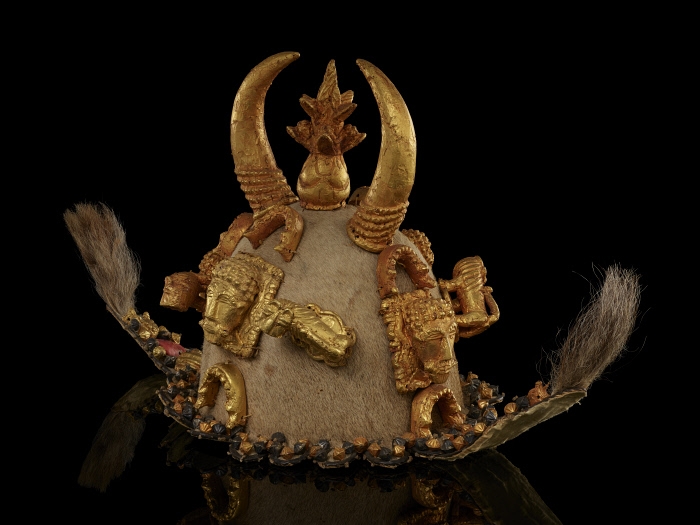
Quick stop at the royal court of the Asante Kingdom in Ghana, where the Denkyemkye holds a special place of honor, representing both material wealth and spiritual powers. This ceremonial cap, also known as the “Crocodile Cap,” is adorned with intricate gold decorations, including symbols like human jawbones, lions, and miniature enemy heads—each element representing strength, courage, and the king’s ability to protect his people. The gold amulets (bosum) attached to its exterior are said to guard the king against evil spirits and physical harm, while Islamic amulets (safis) on the inside provide additional spiritual protection.
The Greek Ruby Parure Tiara (Greece)
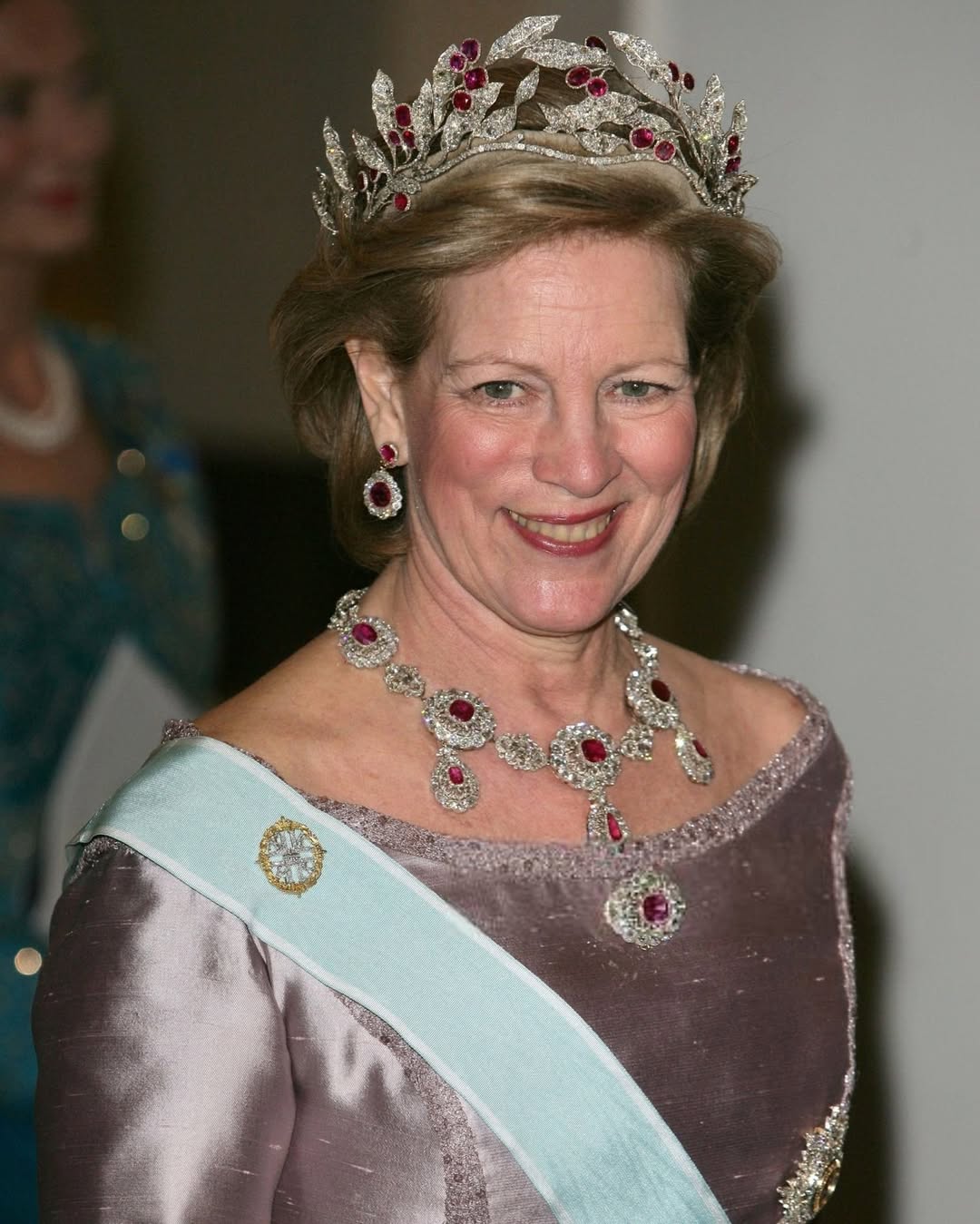
We are now in Greece! The Greek Ruby Parure Tiara has its origins in the 19th century when it was gifted to Queen Olga of Greece by her husband, King George I. The tiara features all the pigeon-blood rubies that King George I of Greece gave to Queen Olga for each of their anniversaries. The tiara, part of a larger set of jewels, has stunning rubies set among diamond clusters shaped like olive leaves, echoing ancient Greek wreaths. The parure also consists of a pair of earrings and two brooches, one with a pendant and the other without. The piece has since been passed down through generations and is regularly worn by Queen Anne-Marie of Greece. Despite the Greek monarchy being abolished, the tiara remains in the royal family’s possession and makes frequent appearances at royal events.
The Arab Scroll Tiara (Jordan)
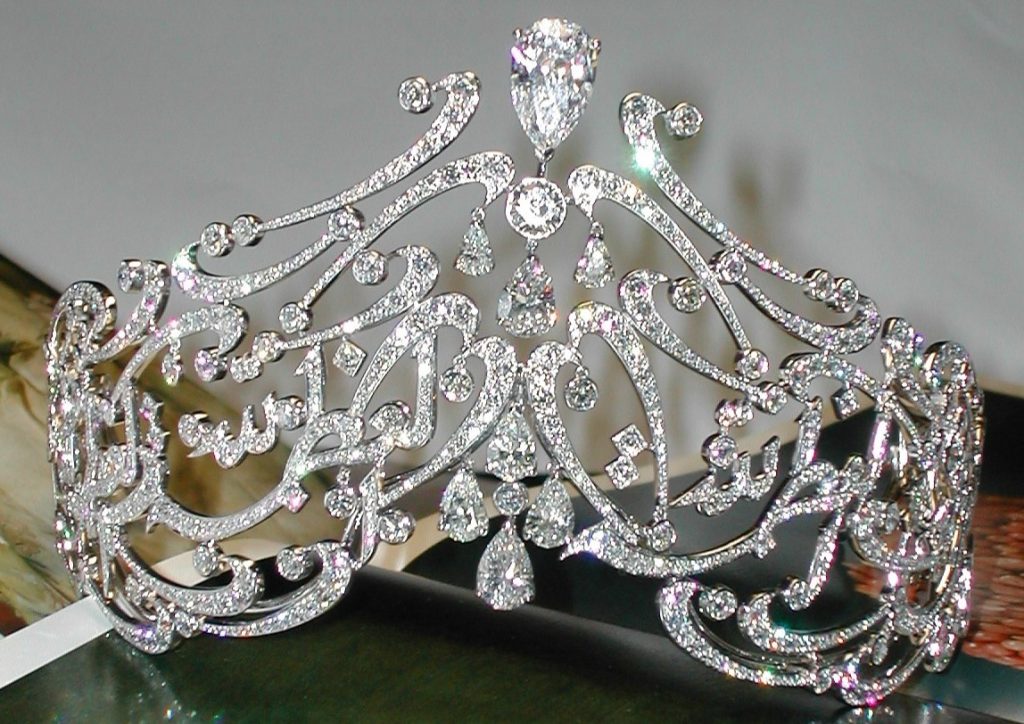
Our royal tour ends with the Arab Scroll Tiara, created for Queen Rania of Jordan in 2005, a modern masterpiece that speaks to heritage, religion, and dedicated craftsmanship. Designed with Arabic script from the Quran, the tiara is an exquisite blend of cultural heritage and modern design. It’s set with 1,300 diamonds, including a breathtaking 20-carat pear-shaped diamond at its peak. The script translates to “God is great,” emphasizing the spiritual connection between the Jordanian monarchy and Islam. Queen Rania first wore this tiara during a state visit to the Netherlands in 2006 and again in 2024 for her official Silver Jubilee portrait.
And thus, our journey through the world’s most legendary crowns and tiaras comes to a poignant end. Each of these crowns and tiaras is not merely a work of artistry; they are living, breathing symbols of power, history, and the passage of time. They carry with them stories of love, loss, triumph, and tragedy, linking the present to a storied past and reminding us of the immortality of monarchy.
Featured image: Getty Images

Sewelo is a world where jewelry, watches, and objects come alive in a shimmering dance of fantasy. Through a literary lens, we celebrate the beauty and elegance that make these treasures more than just possessions.


